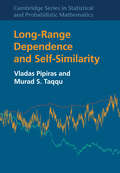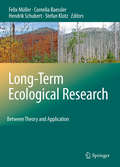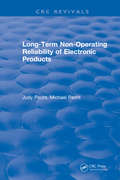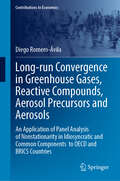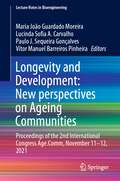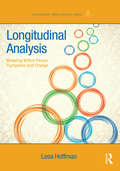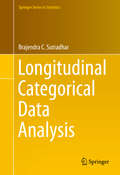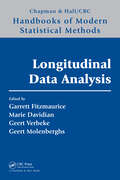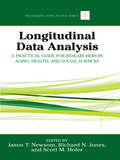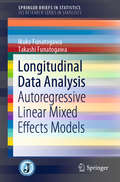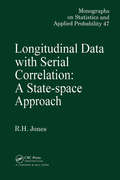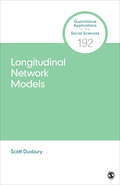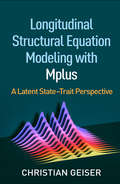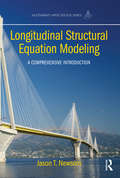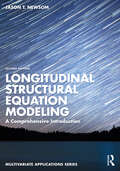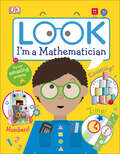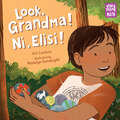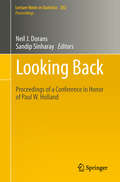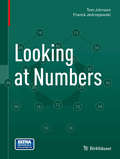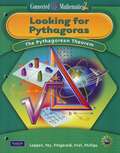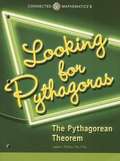- Table View
- List View
Long-Range Dependence and Self-Similarity (Cambridge Series in Statistical and Probabilistic Mathematics #45)
by Vladas Pipiras Murad S. TaqquThis modern and comprehensive guide to long-range dependence and self-similarity starts with rigorous coverage of the basics, then moves on to cover more specialized, up-to-date topics central to current research. These topics concern, but are not limited to, physical models that give rise to long-range dependence and self-similarity; central and non-central limit theorems for long-range dependent series, and the limiting Hermite processes; fractional Brownian motion and its stochastic calculus; several celebrated decompositions of fractional Brownian motion; multidimensional models for long-range dependence and self-similarity; and maximum likelihood estimation methods for long-range dependent time series. Designed for graduate students and researchers, each chapter of the book is supplemented by numerous exercises, some designed to test the reader's understanding, while others invite the reader to consider some of the open research problems in the field today.
Long-Term Ecological Research
by Felix Müller Cornelia Baessler Hendrik Schubert Stefan KlotzEcosystems change on a multitude of spatial and temporal scales. While analyses of ecosystem dynamics in short timespans have received much attention, the impacts of changes in the long term have, to a great extent, been neglected, provoking a lack of information and methodological know-how in this area. This book fills this gap by focusing on studies dealing with the investigation of complex, long-term ecological processes with regard to global change, the development of early warning systems, and the acquisition of a scientific basis for strategic conservation management and the sustainable use of ecosystems. Within this book, theoretical ecological questions of long-term processes, as well as an international dimension of long-term monitoring, observations and research are brought together. The outcome is an overview on different aspects of long-term ecological research. Aquatic, as well as terrestrial ecosystems are represented.
Long-Term Health State Estimation of Energy Storage Lithium-Ion Battery Packs
by Qi Huang Shunli Wang Carlos Fernandez Zonghai Chen Ran Xiong Daniel-I. StroeThis book investigates in detail long-term health state estimation technology of energy storage systems, assessing its potential use to replace common filtering methods that constructs by equivalent circuit model with a data-driven method combined with electrochemical modeling, which can reflect the battery internal characteristics, the battery degradation modes, and the battery pack health state. Studies on long-term health state estimation have attracted engineers and scientists from various disciplines, such as electrical engineering, materials, automation, energy, and chemical engineering. Pursuing a holistic approach, the book establishes a fundamental framework for this topic, while emphasizing the importance of extraction for health indicators and the significant influence of electrochemical modeling and data-driven issues in the design and optimization of health state estimation in energy storage systems. The book is intended for undergraduate and graduate students who are interested in new energy measurement and control technology, researchers investigating energy storage systems, and structure/circuit design engineers working on energy storage cell and pack.
Long-Term Non-Operating Reliability of Electronic Products (Electronic Packaging Ser.)
by Judy PechtIn today's electronic environment, operating reliability for continued daily use of electronic products is essential. This book discusses the reliability of products that lie dormant for long periods of time and are subject to stresses such as humidity, ionic contaminants, temperature, radiation, shock, and vibration. Non-operating reliability is especially critical for life-saving electronic products such as fire alarm systems, standby power sources, and burglar alarms. Air bags in automobiles, earthquake alarm systems, and radiation warning systems in nuclear power plants are also covered. This physics-of-failure approach is also important to maintaining defense hardware such as missiles and munitions systems which often lie dormant for years before being deployed on very short notice
Long-run Convergence in Greenhouse Gases, Reactive Compounds, Aerosol Precursors and Aerosols: An Application of Panel Analysis of Nonstationarity in Idiosyncratic and Common Components to OECD and BRICS Countries (Contributions to Economics)
by Diego Romero-ÁvilaThis book examines the presence of stochastic and deterministic convergence in ten series of greenhouse gases, aerosol precursors, and aerosols across 29 industrialized and emerging countries from 1820 to 2018. The author utilizes the Panel Analysis of Nonstationarity in Idiosyncratic and Common Components (PANIC) method for the empirical exercise. The analysis reveals strong evidence of stochastic convergence patterns in the series of log per capita emissions for black carbon, carbon monoxide, ammonia, non-methane volatile organic compounds, and nitrogen oxides, demonstrated by the existence of pairwise cointegration among individual series. Regarding deterministic convergence, the book provides compelling evidence of convergence in per capita emissions for black carbon, carbon monoxide, ammonia, non-methane volatile organic compounds, nitrogen oxides, and sulfur dioxide. There is also moderate evidence of convergence in per capita emissions for carbon dioxide, nitrous oxide, and organic carbon, and weaker evidence for methane emissions. The findings have significant implications for environmental policy, particularly in light of the observed deterministic convergence in emissions.
Longevity and Development: Proceedings of the 2nd International Congress Age.Comm, November 11–12, 2021 (Lecture Notes in Bioengineering)
by Maria João Guardado Moreira Lucinda Sofia A. Carvalho Paulo J. Sequeira Gonçalves Vítor Manuel Barreiros PinheiraThis book focuses on the dynamic process of aging and on interventions to support the development of older and integrated societies, from a multidisciplinary point of view. Gathering contributions from researchers and professionals with different backgrounds, including social and health sciences, education, engineering and IT, biology, geography and environmental science, it aims at understanding the phenomenon of population aging, in order to contribute to the development of future functional communities, fostering well-being and autonomy of the elderly, their integration and participation. Based on the proceedings of the 2nd International Congress Age.Comm Longevity and Development, organised online on November 11-12, 2021, from Castelo Branco, Portugal, this book addresses a wide range of specialists dealing with the process of aging, integration and community development in the societies of the future.
Longitudinal Analysis: Modeling Within-Person Fluctuation and Change (Multivariate Applications Series)
by Lesa HoffmanLongitudinal Analysis provides an accessible, application-oriented treatment of introductory and advanced linear models for within-person fluctuation and change. Organized by research design and data type, the text uses in-depth examples to provide a complete description of the model-building process. The core longitudinal models and their extensions are presented within a multilevel modeling framework, paying careful attention to the modeling concerns that are unique to longitudinal data. Written in a conversational style, the text provides verbal and visual interpretation of model equations to aid in their translation to empirical research results. Overviews and summaries, boldfaced key terms, and review questions will help readers synthesize the key concepts in each chapter. Written for non-mathematically-oriented readers, this text features: A description of the data manipulation steps required prior to model estimation so readers can more easily apply the steps to their own data An emphasis on how the terminology, interpretation, and estimation of familiar general linear models relates to those of more complex models for longitudinal data Integrated model comparisons, effect sizes, and statistical inference in each example to strengthen readers’ understanding of the overall model-building process Sample results sections for each example to provide useful templates for published reports Examples using both real and simulated data in the text, along with syntax and output for SPSS, SAS, STATA, and Mplus at www.PilesOfVariance.com to help readers apply the models to their own data The book opens with the building blocks of longitudinal analysis—general ideas, the general linear model for between-person analysis, and between- and within-person models for the variance and the options within repeated measures analysis of variance. Section 2 introduces unconditional longitudinal models including alternative covariance structure models to describe within-person fluctuation over time and random effects models for within-person change. Conditional longitudinal models are presented in section 3, including both time-invariant and time-varying predictors. Section 4 reviews advanced applications, including alternative metrics of time in accelerated longitudinal designs, three-level models for multiple dimensions of within-person time, the analysis of individuals in groups over time, and repeated measures designs not involving time. The book concludes with additional considerations and future directions, including an overview of sample size planning and other model extensions for non-normal outcomes and intensive longitudinal data. Class-tested at the University of Nebraska-Lincoln and in intensive summer workshops, this is an ideal text for graduate-level courses on longitudinal analysis or general multilevel modeling taught in psychology, human development and family studies, education, business, and other behavioral, social, and health sciences. The book’s accessible approach will also help those trying to learn on their own. Only familiarity with general linear models (regression, analysis of variance) is needed for this text.
Longitudinal Categorical Data Analysis
by Brajendra C. SutradharThis is the first book in longitudinal categorical data analysis with parametric correlation models developed based on dynamic relationships among repeated categorical responses. This book is a natural generalization of the longitudinal binary data analysis to the multinomial data setup with more than two categories. Thus, unlike the existing books on cross-sectional categorical data analysis using log linear models, this book uses multinomial probability models both in cross-sectional and longitudinal setups. A theoretical foundation is provided for the analysis of univariate multinomial responses, by developing models systematically for the cases with no covariates as well as categorical covariates, both in cross-sectional and longitudinal setups. In the longitudinal setup, both stationary and non-stationary covariates are considered. These models have also been extended to the bivariate multinomial setup along with suitable covariates. For the inferences, the book uses the generalized quasi-likelihood as well as the exact likelihood approaches. The book is technically rigorous, and, it also presents illustrations of the statistical analysis of various real life data involving univariate multinomial responses both in cross-sectional and longitudinal setups. This book is written mainly for the graduate students and researchers in statistics and social sciences, among other applied statistics research areas. However, the rest of the book, specifically the chapters from 1 to 3, may also be used for a senior undergraduate course in statistics.
Longitudinal Data Analysis (Chapman & Hall/CRC Handbooks of Modern Statistical Methods)
by Marie Davidian Geert Molenberghs Garrett Fitzmaurice Geert VerbekeAlthough many books currently available describe statistical models and methods for analyzing longitudinal data, they do not highlight connections between various research threads in the statistical literature. Responding to this void, Longitudinal Data Analysis provides a clear, comprehensive, and unified overview of state-of-the-art theory
Longitudinal Data Analysis: A Practical Guide for Researchers in Aging, Health, and Social Sciences (Multivariate Applications Series)
by Scott M. Hofer Jason T. Newsom Richard N. JonesThis book provides accessible treatment to state-of-the-art approaches to analyzing longitudinal studies. Comprehensive coverage of the most popular analysis tools allows readers to pick and choose the techniques that best fit their research. The analyses are illustrated with examples from major longitudinal data sets including practical information about their content and design. Illustrations from popular software packages offer tips on how to interpret the results. Each chapter features suggested readings for additional study and a list of articles that further illustrate how to implement the analysis and report the results. Syntax examples for several software packages for each of the chapter examples are provided at www.psypress.com/longitudinal-data-analysis. Although many of the examples address health or social science questions related to aging, readers from other disciplines will find the analyses relevant to their work. In addition to demonstrating statistical analysis of longitudinal data, the book shows how to interpret and analyze the results within the context of the research design. The methods covered in this book are applicable to a range of applied problems including short- to long-term longitudinal studies using a range of sample sizes. The book provides non-technical, practical introductions to the concepts and issues relevant to longitudinal analysis. Topics include use of publicly available data sets, weighting and adjusting for complex sampling designs with longitudinal studies, missing data and attrition, measurement issues related to longitudinal research, the use of ANOVA and regression for average change over time, mediation analysis, growth curve models, basic and advanced structural equation models, and survival analysis. An ideal supplement for graduate level courses on data analysis and/or longitudinal modeling taught in psychology, gerontology, public health, human development, family studies, medicine, sociology, social work, and other behavioral, social, and health sciences, this multidisciplinary book will also appeal to researchers in these fields.
Longitudinal Data Analysis: Autoregressive Linear Mixed Effects Models (SpringerBriefs in Statistics)
by Ikuko Funatogawa Takashi FunatogawaThis book provides a new analytical approach for dynamic data repeatedly measured from multiple subjects over time. <P><P>Random effects account for differences across subjects. Auto-regression in response itself is often used in time series analysis. In longitudinal data analysis, a static mixed effects model is changed into a dynamic one by the introduction of the auto-regression term. Response levels in this model gradually move toward an asymptote or equilibrium which depends on covariates and random effects. <P><P>The book provides relationships of the autoregressive linear mixed effects models with linear mixed effects models, marginal models, transition models, nonlinear mixed effects models, growth curves, differential equations, and state space representation. State space representation with a modified Kalman filter provides log likelihoods for maximum likelihood estimation, and this representation is suitable for unequally spaced longitudinal data. <P><P>The extension to multivariate longitudinal data analysis is also provided. Topics in medical fields, such as response-dependent dose modifications, response-dependent dropouts, and randomized controlled trials are discussed. <P><P>The text is written in plain terms understandable for researchers in other disciplines such as econometrics, sociology, and ecology for the progress of interdisciplinary research.
Longitudinal Data with Serial Correlation: A State-Space Approach (Chapman & Hall/CRC Monographs on Statistics and Applied Probability)
by Richard .H. JonesThis monograph is written for students at the graduate level in biostatistics, statistics or other disciplines that collect longitudinal data. It concentrates on the state space approach that provides a convenient way to compute likelihoods using the Kalman filter.
Longitudinal Multivariate Psychology (Multivariate Applications Series)
by Emilio Ferrer Steven M. Boker Kevin J. GrimmThis volume presents a collection of chapters focused on the study of multivariate change. As people develop and change, multivariate measurement of that change and analysis of those measures can illuminate the regularities in the trajectories of individual development, as well as time-dependent changes in population averages. As longitudinal data have recently become much more prevalent in psychology and the social sciences, models of change have become increasingly important. This collection focuses on methodological, statistical, and modeling aspects of multivariate change and applications of longitudinal models to the study of psychological processes. The volume is divided into three major sections: Extension of latent change models, Measurement and testing issues in longitudinal modeling, and Novel applications of multivariate longitudinal methodology. It is intended for advanced students and researchers interested in learning about state-of-the-art techniques for longitudinal data analysis, as well as understanding the history and development of such techniques.
Longitudinal Network Models (Quantitative Applications in the Social Sciences)
by Scott DuxburyAlthough longitudinal social network data are increasingly collected, there are few guides on how to navigate the range of available tools for longitudinal network analysis. The applied social scientist is left to wonder: Which model is most appropriate for my data? How should I get started with this modeling strategy? And how do I know if my model is any good? This book answers these questions. Author Scott Duxbury assumes that the reader is familiar with network measurement, description, and notation, and is versed in regression analysis, but is likely unfamiliar with statistical network methods. The goal of the book is to guide readers towards choosing, applying, assessing, and interpreting a longitudinal network model, and each chapter is organized with a specific data structure or research question in mind. A companion website includes data and R code to replicate the examples in the book.
Longitudinal Network Models (Quantitative Applications in the Social Sciences)
by Scott DuxburyAlthough longitudinal social network data are increasingly collected, there are few guides on how to navigate the range of available tools for longitudinal network analysis. The applied social scientist is left to wonder: Which model is most appropriate for my data? How should I get started with this modeling strategy? And how do I know if my model is any good? This book answers these questions. Author Scott Duxbury assumes that the reader is familiar with network measurement, description, and notation, and is versed in regression analysis, but is likely unfamiliar with statistical network methods. The goal of the book is to guide readers towards choosing, applying, assessing, and interpreting a longitudinal network model, and each chapter is organized with a specific data structure or research question in mind. A companion website includes data and R code to replicate the examples in the book.
Longitudinal Structural Equation Modeling with Mplus: A Latent State-Trait Perspective (Methodology in the Social Sciences)
by Christian GeiserAn in-depth guide to executing longitudinal confirmatory factor analysis (CFA) and structural equation modeling (SEM) in Mplus, this book uses latent state–trait (LST) theory as a unifying conceptual framework, including the relevant coefficients of consistency, occasion specificity, and reliability. Following a standard format, chapters review the theoretical underpinnings, strengths, and limitations of the various models; present data examples; and demonstrate each model's application and interpretation in Mplus, with numerous screen shots and output excerpts. Coverage encompasses both traditional models (autoregressive, change score, and growth curve models) and LST models for analyzing single- and multiple-indicator data. The book discusses measurement equivalence testing, intensive longitudinal data modeling, and missing data handling, and provides strategies for model selection and reporting of results. User-friendly features include special-topic boxes, chapter summaries, and suggestions for further reading. The companion website features data sets, annotated syntax files, and output for all of the examples.
Longitudinal Structural Equation Modeling: A Comprehensive Introduction (Multivariate Applications Series)
by Jason T. NewsomThis comprehensive resource reviews structural equation modeling (SEM) strategies for longitudinal data to help readers see which modeling options are available for which hypotheses. The author demonstrates how SEM is related to other longitudinal data techniques throughout. By exploring connections between models, readers gain a better understanding of when to choose one analysis over another. The book explores basic models to sophisticated ones including the statistical and conceptual underpinnings that are the building blocks of the analyses.? Accessibly written, research examples from the behavioral and social sciences and results interpretations are provided throughout. The emphasis is on concepts and practical guidance for applied research rather than on mathematical proofs. New terms are highlighted and defined in the glossary. Figures are included for every model along with detailed discussions of model specification and implementation issues.? Each chapter also includes examples of each model type, comment sections that provide practical guidance, model extensions, and recommended readings. Highlights include: Covers the major SEM approaches to longitudinal analysis in one resource. Explores connections between longitudinal SEM models to enhance integration.? Numerous examples that help readers match research questions to appropriate analyses and interpret results. Reviews practical issues related to model specification and estimation to reinforce connections.? Analyzes continuous and discrete (binary and ordinal) variables throughout for breadth not found in other sources. Reviews key SEM concepts for those who need a refresher (Ch. 1).? Emphasizes how to apply and interpret each model through realistic data examples. Provides the book’s data sets at www.longitudinalsem.com along with the Mplus and R-lavaan syntax used to generate the results. Introduces the LISREL notation system used throughout (Appendix A).? The chapters can be read out of order but it is best to read chapters 1 – 4 first because most of the later chapters refer back to them. The book opens with a review of latent variables and analysis of binary and ordinal variables. Chapter 2 applies this information to assessing longitudinal measurement invariance.? SEM tests of dependent means and proportions over time points are explored in Chapter 3, and stability and change, difference scores, and lagged regression are covered in Chapter 4. The remaining chapters are each devoted to one major type of longitudinal SEM -- repeated measures analysis models, full cross-lagged panel models and simplex models, modeling stability with state-trait models, linear and nonlinear growth curve models, latent difference score models, latent transition analysis, time series analysis, survival analysis, and attrition. Missing data is discussed in the context of many of the preceding models in Chapter 13.? Ideal for graduate courses on longitudinal (data) analysis, advanced SEM, longitudinal SEM, and/or advanced data (quantitative) analysis taught in the behavioral, social, and health sciences, this text also appeals to researchers in these fields. Intended for those without an extensive math background, prerequisites include familiarity with basic SEM. Matrix algebra is avoided in all but a few places.
Longitudinal Structural Equation Modeling: A Comprehensive Introduction (Multivariate Applications Series)
by Jason T. NewsomLongitudinal Structural Equation Modeling is a comprehensive resource that reviews structural equation modeling (SEM) strategies for longitudinal data to help readers determine which modeling options are available for which hypotheses. This accessibly written book explores a range of models, from basic to sophisticated, including the statistical and conceptual underpinnings that are the building blocks of the analyses. By exploring connections between models, it demonstrates how SEM is related to other longitudinal data techniques and shows when to choose one analysis over another. Newsom emphasizes concepts and practical guidance for applied research rather than focusing on mathematical proofs, and new terms are highlighted and defined in the glossary. Figures are included for every model along with detailed discussions of model specification and implementation issues and each chapter also includes examples of each model type, descriptions of model extensions, comment sections that provide practical guidance, and recommended readings. Expanded with new and updated material, this edition includes many recent developments, a new chapter on growth mixture modeling, and new examples. Ideal for graduate courses on longitudinal (data) analysis, advanced SEM, longitudinal SEM, and/or advanced data (quantitative) analysis taught in the behavioral, social, and health sciences, this new edition will continue to appeal to researchers in these fields.
Look I'm a Mathematician (Look! I'm Learning)
by DKThis playful preschool math activity book will unleash your child's curiosity as they play their way through 20 fantastic math projects.Each easy step-by-step activity is hands-on and practical to encourage budding mathematicians to use their senses. Look I'm A Mathematician explores essential math topics to get children prepared for school - the perfect math ebook for kids ages 3 to 6.Look I'm A Mathematician is full of activities to show young readers just how much fun math can be!Children will discover that math has a part in everything in the world and that they already have the tools they need to become magical mathematicians - a curious mind, unlimited imagination, and super senses. A great introduction to learning math, this ebook teaches kids the magic of numbers through play with number bugs, creating a hungry adding robot, learning about subtraction by playing skittles, crafting 3D shape aliens, and even making a repeating pattern fruit wand. Covering a comprehensive range of math topics, from counting and numbers to shape and size, and measurements and time, this is the perfect first math ebook for children. Every fun project features a mixture of bright photography and charming illustrations that support the easy-to-follow activity instructions. These creative hands-on activities support classroom math taught in schools.Look I'm A Mathematician allows little readers to do what they do best - imagine, create, learn, problem-solve, and play their way to math magic!Try Out Amazing Projects!You don't need a fancy calculator or a whiteboard full of big numbers to be a mathematician. You already have everything you need - your amazing brain and your senses!Look I'm A Mathematician is full of puzzles to solve, things to work out, and brain teasers. This educational ebook is full of fun math activities for kids like: - A math treasure hunt- Making shape aliens- Measuring things- Clever counting - And much, much more!DK's Look! I'm Learning series of exciting and educational STEM ebooks, focus on the sensory experience of practical learning and play. Hands-on learning experiences tap straight into kids' insatiable curiosity and sense of wonder. These ebooks for children are perfect for ages 3 – 6, formatted with a padded cover and toddler-tough pages. The series encourages children to develop independence and improves their critical thinking, investigation skills, and motor skills. Try the other titles in the series next, including Look I'm A Cook, Look I'm A Scientist, and Look I'm An Engineer.
Look, Grandma! Ni, Elisi! (Storytelling Math)
by Art CoulsonCelebrate diversity, math, and the power of storytelling!Bo wants to find the perfect container to show off his traditional marbles for the Cherokee national Holiday. It needs to be just the right size: big enough to fit all the marbles, but not too big to fit in his family's booth at the festival for the Cherokee National Holiday. And it needs to look good! With his grandmother's help, Bo tries many containers until he finds just the right one. A playful exploration of volume and capacity featuring Native characters and a glossary of Cherokee words.Storytelling Math celebrates children using math in their daily adventures as they play, build, and discover the world around them. Joyful stories and hands-on activities make it easy for kids and their grown-ups to explore everyday math together. Developed in collaboration with math experts at STEM education nonprofit TERC, under a grant from the Heising-Simons Foundation.
Looking Back
by Neil J. Dorans Sandip SinharayIn 2006, Paul W. Holland retired from Educational Testing Service (ETS) after a career spanning five decades. In 2008, ETS sponsored a conference, Looking Back, honoring his contributions to applied and theoretical psychometrics and statistics. Looking Back attracted a large audience that came to pay homage to Paul Holland and to hear presentations by colleagues who worked with him in special ways over those 40+ years. This book contains papers based on these presentations, as well as vignettes provided by Paul Holland before each section. The papers in this book attest to how Paul Holland's pioneering ideas influenced and continue to influence several fields such as social networks, causal inference, item response theory, equating, and DIF. He applied statistical thinking to a broad range of ETS activities in test development, statistical analysis, test security, and operations. The original papers contained in this book provide historical context for Paul Holland's work alongside commentary on some of his major contributions by noteworthy statisticians working today.
Looking at Numbers
by Tom Johnson Franck JedrzejewskiGalileo Galilei said he was "reading the book of nature" as he observed pendulums swinging, but he might also simply have tried to draw the numbers themselves as they fall into networks of permutations or form loops that synchronize at different speeds, or attach themselves to balls passing in and out of the hands of good jugglers. Numbers are, after all, a part of nature. As such, looking at and thinking about them is a way of understanding our relationship to nature. But when we do so in a technical, professional way, we tend to overlook their basic attributes, the things we can understand by simply "looking at numbers. " Tom Johnson is a composer who uses logic and mathematical models, such as combinatorics of numbers, in his music. The patterns he finds while "looking at numbers" can also be explored in drawings. This book focuses on such drawings, their beauty and their mathematical meaning. The accompanying comments were written in collaboration with the mathematician Franck Jedrzejewski.
Looking for Pythagoras, The Pythagorean Theorem
by Glenda Lappan James T. Fey William M. Fitzgerald Susan N. Friel Elizabeth Difanis PhillipsNIMAC-sourced textbook
Looking for Pythagoras: The Pythagorean Theorem
by Glenda Lappan James T. Fey Susan N. Friel Elizabeth Difanis PhillipsNIMAC-sourced textbook
